While cleaning the Belen, particularly bringing inside the image of Mary an idea crossed my mind. I commissioned the additional face and hands of Mary as a sign of respect to my first Marian image when I lovingly dedicated it to Our Lady of the Rosary. Prior to that, I used that image for all my "Marian" needs eg Our Lady of Fatima procession, Flores de Mayo, Christmas Belen etc. So in 2008, when I decided that the image will once and for all be known as Our Lady of the Rosary, I am faced with a dilemma: what will I use for my other "Marian" needs moving forward? Plus I have in my possession an extra body, set of hands and other accessories...
When the image arrived and since then, I had a love-hate relationship with it. I have tasked Nick Lugue to copy the face of one of the pilgrim images of Our Lady of Fatima however whenever I look at it, I feel there's something wrong--is it proportion, is it expectation, is it because a friend told me that after an accident, Mang Nick's work is not like what it used to be etc. It does not 100% resemble the face I was expecting to see, and it does not look like anything Nick Lugue made (although it was signed). l can't seem to warm up to the image. My mom further adds that the image looks sick, very thin and pale (and that of course is not something you would want anyone to say to your image of Mary because Our Lady should always be depicted as beautiful and perfect). Countless of times, I have tried to schedule a visit back to the Lugue's in Apalit to have the image "fixed," but my schedule does not permit and it dragged on from 2008 until this year...
Back in February, holding the image in my hands an idea crossed my mind. All this time I wanted to have the image fixed, correct whatever is wrong with the face I can't seem to be happy on. And then commission another set of head and hands for another Marian image or a Santa for Holy Week use so that Mang Nick would not feel that I am taking advantage (since I was insisting that since I am not satisfied with the output, and the customer is always right, fixing it should be free). And ever since I was able to successfully convince my family that I will be including my Kristong Gapos in our hometown's Holy Week procession, I've been playing with the thought of adding a female santa in our line-up, either of Sta. Maria Cleofe or of Sta. Marta (my favorite Holy Week santa). But the image of Sta. Maria Cleofe has more pressing need. (By the way for the record, in my head I've been thinking of someday adding an image of the scourging and the crucifixion to our line-up.) And I thought, what if the head and hands right now that I have is the one I use for Sta. Maria Cleofe, since I am having a difficult time looking at it as a Marian image, and then have a new one made. And so I did just that and pushed on with that plan. A side thought though in this experience, is it best to direct an artist to follow the image the way you see it or is it best to allow the artist to carve the image based on what he sees? I actually go to Nick Lugue because I like his work and I look for that "Nick Lugue style" and yet in my past experiences giving santeros the free hand does not always end happily. Decisions...decisions...
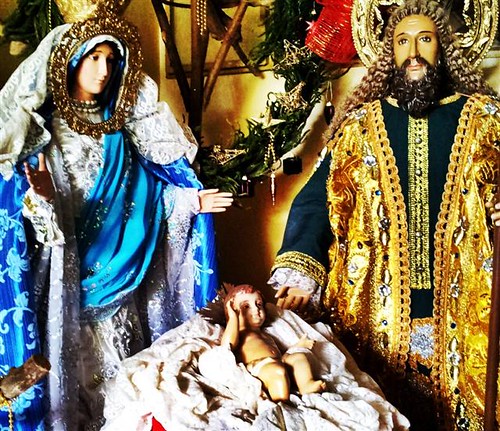
The image as Mary
The Dress Rehearsal
After convincing myself that it can be done, and after a few dress rehearsals (using old dresses of Mama Mary which no longer fits her--she does keep growing) the next challenge is to make it known to my family and of course make it happen...from accessories, to the carroza which will be used during the procession.
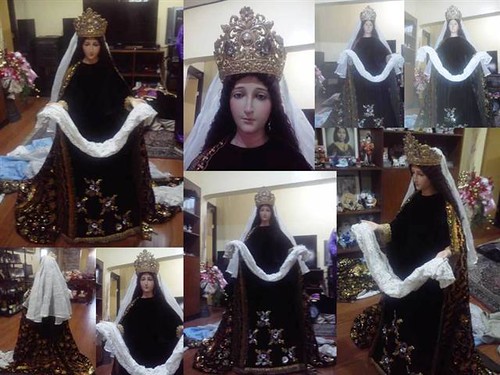
Option 1 for Good Friday, an all black dress and cape with white chiffon veil...topped with Beata Imelda's crown...hmmm...the cape is too overpowering...next...
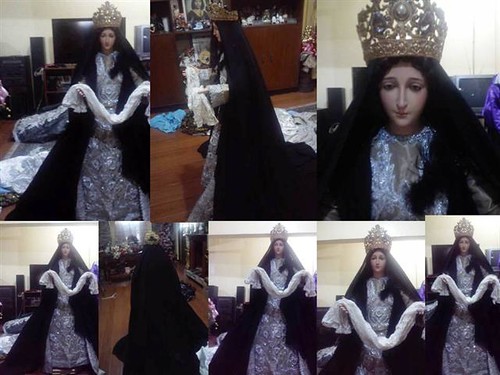
Option 2, silver and black, a huge black chiffon to cover all the gold and silver. I like!
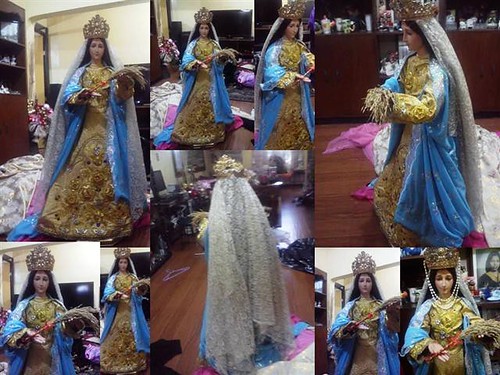
For Easter...a gold dress with a light blue beaded cape from my Tita in Saudi and an antique looking white lace with gold flowers as veil. Done!
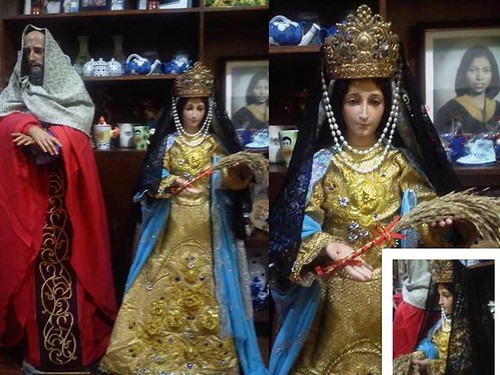
For Easter, prior to the veil of the Virgen Alegria being removed by the angel, the image of Sta. Maria Cleofe will also have a black veil which will be removed after. This is an old tradition of santa owners back in my hometown which no one is doing any longer...I want to bring it back, and I hope the santa owners will see what I did and follow suit.
With or without Tears
You can call it demotion, or whatever but changing the title or the appearance of an image is not something unusual in the pagsasanto world. And now that I have decided that the image will be Sta. Maria Cleofe, and this is for Holy Week, my next question is should it have tears or not? With tears, at least there's something new and it's not just I changed how the image is dressed. Without tears, they say having glass tears is reserved only for the Mater Dolorosa (well atleast during the the old days).

I started with no tears...

After a trip in Quiapo, now with tears plus eyelashes (why do cockroaches love eating the eyelashes). I thought adding the tears was easy...after having mighty bond all over my hands and the image's face...to make it worse, I ruined the encarna of the face when I tried to clean up the glue residue on the glass tears...good thing it's not too obvious. From afar it just appears as a shadow.
Transformation Complete
Aside from the tears, nothing new was added or corrected on the face of the image but for some reason it looks more beautiful now and I can't seem to remember all the wrong things that bothered me before when looking at it. My Uncle from Marilao even added that it looks good as Sta. Maria Cleofe...it was the right choice...a win-win situation! Problem solved on what I feel not right with the image and now I have a santa for the upcoming Holy Week procession. One can even argue, maybe it is not meant to be a Marian image to start with...
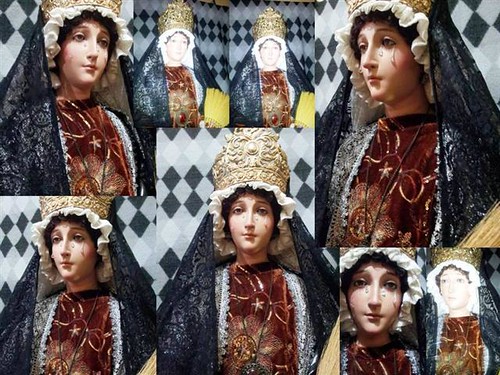
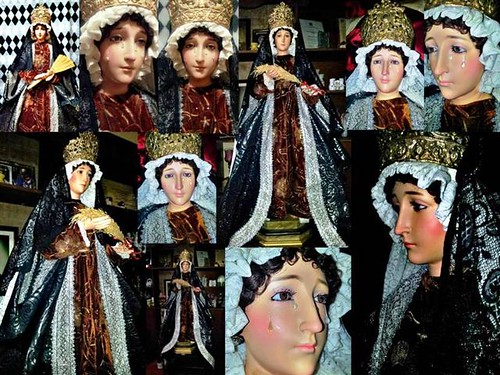
But who is Sta. Maria Cleofe?
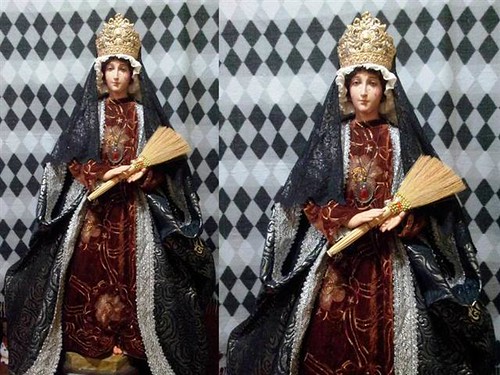
In John 19:25, she was explicitly mentioned, "Now there stood by the cross of Jesus His mother, and His mother’s sister, Mary [the wife] of Clopas, and Mary Magdalene." What does the phrase mother's sister means? There is no doubt that she is one of the pious women of Jerusalem who followed and served Jesus and I guess that is all that matters for her to be rightfully recognized as a saint (and a brave one to be at the foot of the cross whereas Jesus' other disciples all ran away). I found the most logical answer in this website, MARY OF CLEOPHAS by Christopher Y Wong, and I quote:
"All the points that remain obscure would be cleared up, in our opinion, if two hypotheses are risked. Mary, the sister of the Blessed Virgin, having two sons, James and Joseph, by a first marriage, was married a second time to Cleophas, brother of St. Joseph, who also had two sons, Simon and Jude, by a former marriage. In light of the customs of the country and the age, there was nothing extraordinary in the marriage of a widow and a widower, each with children. The second hypothesis is that the sister of the Blessed Virgin had as her first husband a man of the tribe of Levi, called Alpheus.
In this fashion nine or ten problems would be solved. Thus one could explain why James, Joseph, Simon and Jude are always named in that order, as brethren of the Lord; why James and Joseph are a pair distinct from Simon and Jude; why Mary, sister of the Blessed Virgin, is called the mother of James and Joseph and not the mother of Simon and Jude; why, according to Hegesippus, Simon and not James is the son of Cleophas; why, again according to Hegesippus, Simon and Jude are of the family of David; why, according to tradition, James was of sacerdotal ancestry; why the common opinion of Catholics identifies James, son of Mary, sister of the Blessed Virgin, with James the Apostle, the son of Alpheus; why Mary of Cleophas is called in the Gospel sister of the Blessed Virgin, when she was really her sister-in-law, being the wife of St. Joseph's brother; finally, why, after the deaths of Joseph and Cleophas, the two sisters brought their families together, so that thereafter the two families seemed to be but one." (Prat, Jesus Christ, p. 136-137)".
In here it is explained that Sta. Maria Cleofe is the second spouse of the brother or St. Joseph, making her the Virgin's sister in law and the step mother of St. Jude Thaddeus and St. Simon the Zealot. She is of course the mother of St. James the Less and (another)Joseph--that is why she is also know as Sta. Maria Jacobe. I personally believe that Sta. Maria Cleofe and Jacobe are the same, surprisingly in Marikina both are different characters. But there's not much reference in this topic but tradition, making it even harder to separate the identities.

Mary of Cleopas (or Mary of Alphaeus) is the mother of James, Judas Thaddeus (St. Jude), Simon and Joseph. Their father Alphaeus (Cleopas, or Clopas, in Hebrew name) is the brother of Joseph, the spouse of the Blessed Virgin Mother Mary. Thus, Mary Cleopas or Mary of Alphaeus is the sister-in-law of the Blessed Virgin Mary. Of the four sons of Mary and Alphaeus, only James and Thaddeus became Jesus' disciples. Simon later became a believer but Joseph remained indifferent towards Jesus due to the damage that Jesus caused to their reputation. Source: The Poem of the Man-God by Maria Valtorta.
ReplyDeletehttps://santamariacleofas.wordpress.com/2017/01/06/exegetes-identify-mary-of-cleophas-and-mary-of-james-as-one-and-the-same/#_ftn1
ReplyDeletehttps://santamariacleofas.wordpress.com/2017/01/26/exegetes-identify-mary-of-cleophas-and-mary-of-james-as-one-and-the-same-part-ii/
ReplyDeletehttps://santamariacleofas.wordpress.com/2017/01/18/bones-of-contention-the-relics-of-st-mary-of-cleophas-james/
ReplyDeleteOur family also takes care of maria ceopas in our town. Thank you for sharing this article
ReplyDelete